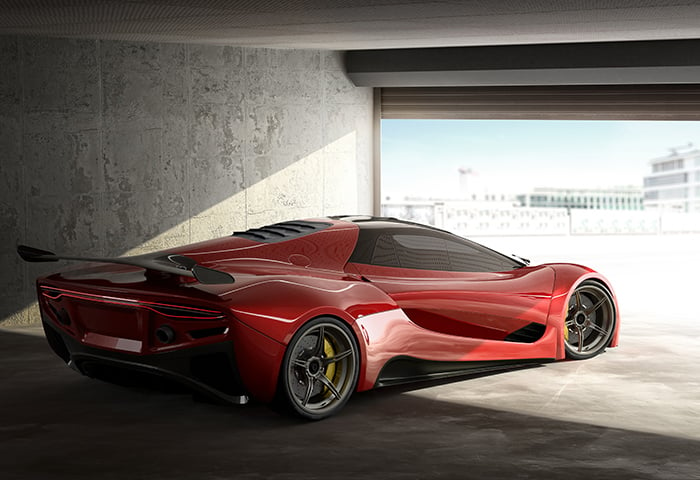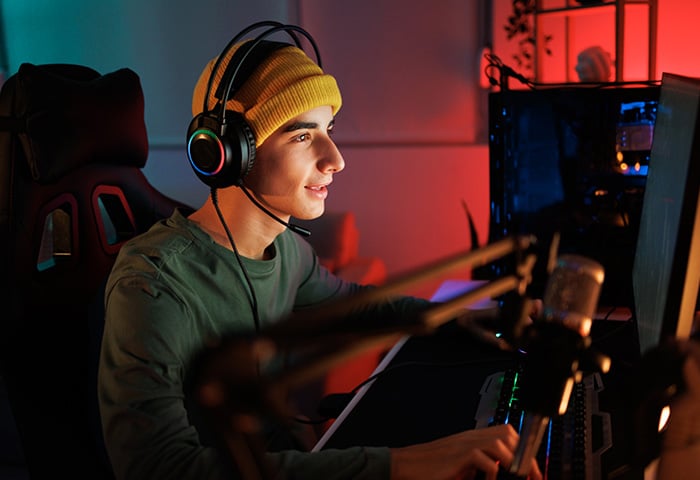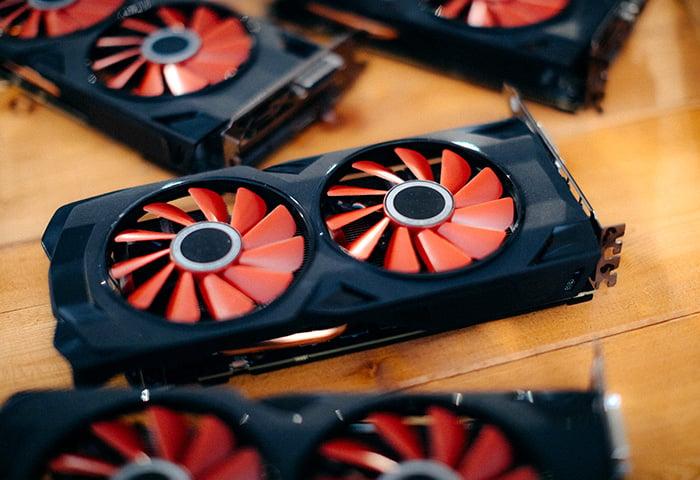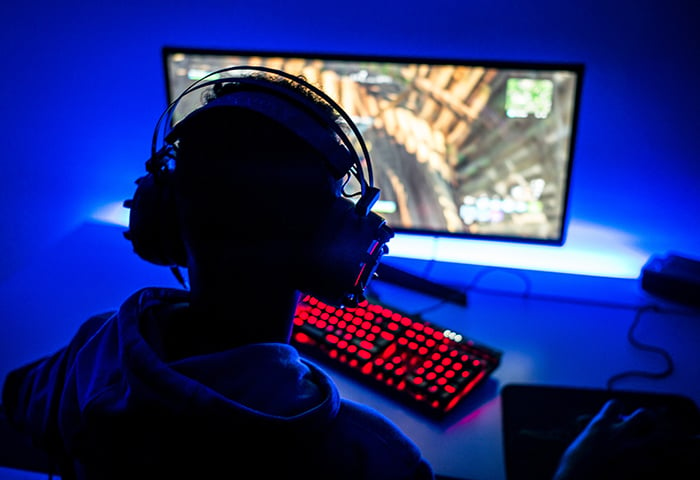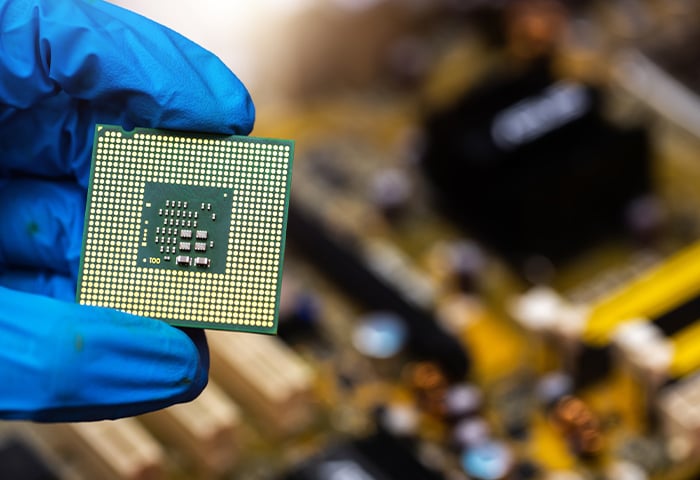What does GPU overclocking mean?
Overclocking your graphics card means gradually increasing the clock speed of your video card to boost its performance. GPU overclocking entails slowly increasing the graphics card’s core frequency to increase its processing power.
Clock speed measures the number of processing cycles per second your card can handle, and it’s set by the manufacturer. Increasing the clock speed results in more computing power and a smoother, better gaming experience, but it can also raise your GPU temperature. So whenever you overclock your GPU, be sure to test its stability with a benchmarking tool to ensure it doesn’t get too hot.
What you need to overclock your GPU
You need two tools to overclock your GPU: one to handle the overclock, and another to test performance. You’ll use the overclocking tool to raise your GPU’s clock rate and the testing tool to benchmark and measure the performance impact of the change.
Before you start overclocking your GPU, make sure your PC is optimized from the ground up and ready to run its best. Read on to learn more about what you need to overclock your GPU, or jump straight to our step-by-step instructions on how to overclock your GPU. And if you want to supercharge your entire computer, check out our dedicated guide to overclocking your CPU.
Here’s what you need to adjust your GPU’s clock rate:
1. One of the best GPU overclocking tools
The best overclocking software is MSI Afterburner. It’s an easy-to-use tool for overclocking your graphics card, includes a skinnable interface to modify settings, and is constantly updated with the latest GPUs. MSI Afterburner also works on non-MSI graphics cards.
 MSI Afterburner.
MSI Afterburner.
For those with NVIDIA graphics cards, NVIDIA Inspector, which is NVIDIA overclocking software, is a great option. And similarly, the AMD GPU overclocking software (AMD Radeon Performance Tuning) can be used on AMD cards. You can try all of the best GPU overclocking software tools for free via the beta release channel on Guru3D.
But, be aware of fake sites claiming to sell the best GPU overclock software out there. Unless the site you’re on is created or moderated by an official developer with a known GPU overclocking tool, it could lead to phishing scams. And using fake GPU overclocking software on your PC can cause irreparable damage to your hardware.
2. A benchmark or stress-test tool
Overclocking your video card increases its temperature and pushes it to its limit, so you need a tool to benchmark performance and make sure you’re not putting it through too much stress. Benchmarking and stress testing also help ensure stability while gaming.
3DMark and FurMark are our picks for the best stress tests for GPU benchmarking.
 FurMark’s GPU stress testing tool.
FurMark’s GPU stress testing tool.
While overclocking is fairly easy with a good tool, be patient, test, and tweak to find the right balance of performance, temperature, and compatibility with the games you play or graphics you need. You might think you’ve reached the perfect GPU or CPU overclock only to find your favorite game like GTA V crashing after just a few minutes. If that happens, try a slightly lower clock rate, then test again.
How to overclock my GPU
First, open your GPU overclocking tool — here we’re using MSI Afterburner. The main dashboard will display your graphics chip’s current clock speed (its GPU Clock) and its memory (Mem Clock). On the right side, you’ll see the temperature. Temps will differ from PC to PC, but as a rule of thumb, avoid GPU and CPU temperatures above 90°C.
 MSI Afterburner’s dashboard.
MSI Afterburner’s dashboard.
The middle sliders of the MSI Afterburner dashboard control the basic overclocking readings:
-
Core voltage: The voltage level that goes into your graphics card — this may not be available on newer cards.
-
Power level: The power slider lets your card draw more power from your power supply unit (PSU). If your card is limited by default to 200 watts, you can increase this to 240 watts by setting it to 120 (20% higher). You may need to do this if you want to overclock your card further (but this will increase the temperature).
-
Core clock: The core clock gauge lets you specify your desired clock rate. You’ll adjust this a lot as you try to find the optimal setting.
-
Memory clock: The memory clock is like your core clock, but it measures your GPU memory.
1. Benchmark your current settings
Check your performance, temperature, clock speeds, and FPS before you start. You can use either 3DMark or Furmark to run a graphics card benchmark test. Write down these numbers, or take a screenshot so you can compare them later.
 Benchmarking performance with FurMark.
Benchmarking performance with FurMark.
2. Overclock your GPU chip
Start slowly when overclocking your video card — raise the core clock rate incrementally by 5% and test for any unusual graphical artifacts like glitches, streaks, or even crashes. At a level of 5%, performance should stay stable, but you likely won’t see much improvement. But this small overclock helps you quickly check for potential issues.
3. Overclock your GPU memory
Memory is as important as the core GPU clock — even more so in games with gigabytes of texture. First, try overclocking GPU memory by 10%, or by 50 to 100 MHz. Anything below 10% should still provide stable performance.
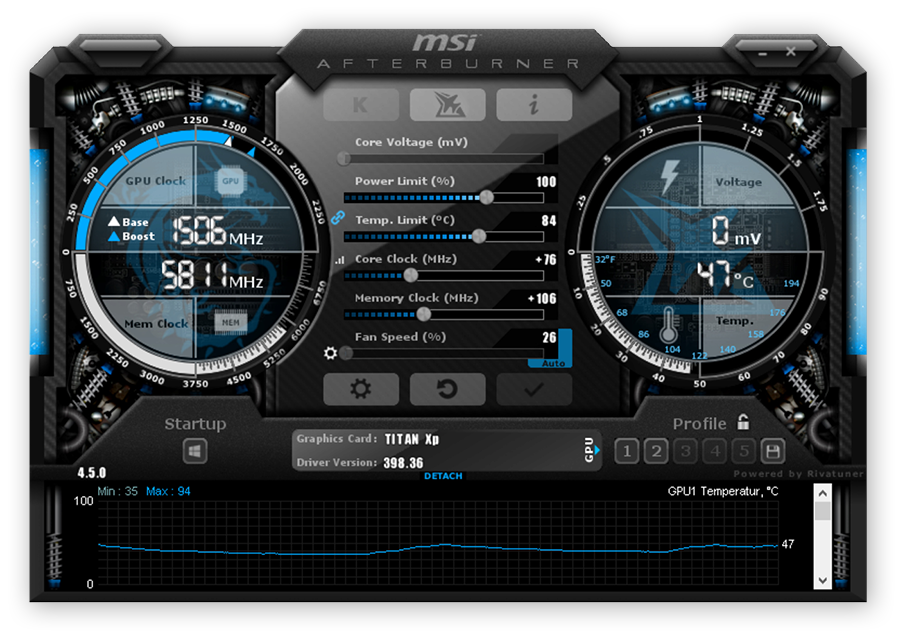 Adjusting your GPU’s memory clock rate with MSI Afterburner.
Adjusting your GPU’s memory clock rate with MSI Afterburner.
If your computer crashes or if your games start malfunctioning, your hardware may not be designed for overlocking at all. You may need to run GPU memory tests as you go, or before you start, to ensure your hardware can handle the stress. Or, increase your computer’s temperature limit.
4. Fine-tune
After gently stress testing the core clock and memory clock rate, continue fine-tuning by slowly increasing your GPU overclock by 10 MHz. Each time, test for stability and performance, and then repeat. Run a benchmark, GPU stress test, or a game for a few hours while checking for issues and monitoring improvements.
If Windows freezes or reboots,you’ve reached your GPU overclocking limit. If that happens, reduce your clock by 10 to 20 MHz. Running an overclock so close to the crashing point means you’ll hit a wall after only a couple hours of gameplay or intensive graphics.
For example, our Titan Xp graphics card performs well at +200 MHz on the core clock, but it gets too hot after two or three hours of playing Ark, Final Fantasy 15, Dark Souls, or The Witcher 3 in 4K. Running it at 170 MHz is a safer bet.
Once you’ve found a stable core clock, do the same with the memory clock. But don’t test your core clock and memory clock at the same time, because if something goes wrong you won’t know which clock setting is responsible.
5. Increase the power limit
Once you’ve hit your limit, you can either keep your clock where it is, or you can turn up the Power Limit and Temperature Limit toggles in MSI Afterburner and see what happens.
 The power and temp limit sliders in MSI Afterburner.
The power and temp limit sliders in MSI Afterburner.
Start your game now. Even without overclocking, you’ll likely notice your computer fans getting louder, and your GPU won’t reduce its clock as fast or as drastically. Use MSI Afterburner’s RivaTuner, which comes with the overclocking tools package, to check and fine-tune your GPU performance.
Enable and configure the onscreen display so you can monitor your GPU’s clock rate and other data while you’re gaming or using your benchmarking tools.
 Display your GPU clock settings while gaming.
Display your GPU clock settings while gaming.
In the PC we use for testing, both Titan Xp GPUs clock up to 1823 MHz by default when playing The Witcher 3. And they drop down to slightly above 1600 MHz after an hour or so, when the temperature is at its peak. But when we use a higher power limit and temperature limit, we don’t see this throttling anymore. And with the right overclock, we never drop below that optimal 2000 MHz level.
6. Fine-tune (again) and test
After unlocking even more power, increase your GPU overclock again by 10 MHz increments and run a GPU test each time. Your card will probably soar past its previous crash point. On our gaming PC, we achieved a GPU overclock of +170 MHz to +450 MHz. Finding the sweet spot took us a lot of fine-tuning, so be patient to get the best results.
Once you find a stable clock, run a graphics card benchmark test again with 3DMark or FurMark. Benchmark your favorite games, too. You’ll see a difference both in numbers and in actual gameplay. You can also use a number of other methods to test your PC’s performance when overclocked.
Does GPU overclocking really work?
Yes, overclocking your GPU usually improves the performance of your games and media apps. More powerful systems may see a smaller benefit from overclocking the graphics card, but if your games typically run at 40 or 50 FPS, an overclocked GPU will result in noticeable improvements.
 Comparing our gaming performance after overclocking the GPU.
Comparing our gaming performance after overclocking the GPU.
Your GPU isn’t the only bit of hardware inside your PC that can benefit from a tune up. And depending on the hardware you have, apps you use, and games you play, a specialized optimization tool like AVG TuneUp can help you get faster performance and more storage space automatically.
Does overclocking GPU increase FPS?
Yes, overclocking a GPU increases FPS. One of the main benefits of overclocking is increased FPS for smoother, sharper graphics while gaming. The added computing power from a GPU overclock helps your graphics card crank out more FPS at higher resolutions.
Is it safe to overclock your GPU?
Yes, GPU overclocking is safe. Overclocking increases the temperature and stress on your GPU, but failsafe mechanisms kick in before the stress becomes too much. If your computer can’t handle the overclock, it will simply crash or freeze. If that happens, lower your GPU overclock and test again.
Running at significantly higher clocks could, in theory, reduce your PC’s lifespan. But we haven’t seen any significant data on the negative impact of GPU overclocking. If you’re worried about how to overclock GPU consistently without causing damage to your hardware, go slowly, be patient, and continue testing to ensure you don’t push things too far.
 Two Titan Xp graphics cards.
Two Titan Xp graphics cards.
How to safely overclock your GPU?
To safely overclock your GPU, increase the clock rate at increments of 10 MHz, and test your system for stability and performance after each adjustment. If your system struggles, lower your overclock by 10 or 20 MHz, then test again. Once you know your maximum GPU overclock frequency, repeat the process with the GPU memory.
Should I overclock my graphics card?
Depending on the strength of your graphics card and how powerful a computer you need, overclocking may not be worth the effort. GPU overclocking boosts FPS and helps improve the performance of games, usually offering strong benefits for gamers — but there are other ways to boost your gaming PC without overclocking your GPU.
What are the most common mistakes when overclocking?
-
Going too fast: If you raise your clock frequencies too quickly, you’ll likely experience crashes, glitches, or even a black screen.
-
Not testing: Failing to test after each incremental clock increase prevents you from monitoring system performance at given clock speeds. It’s easy to go too far if you don’t test properly.
-
Overheating: Overclocking your GPU increases its heat output. To protect your computer from overheating, you’ll want a custom-made card with sufficient cooling ability, or even a water-cooling system in your PC.
-
Auto-overclocking: Your GPU works harder when it’s overclocked, so you don’t need to overclock it continuously. Use MSI Afterburner’s profile system to save your overclock, and use it only when running a demanding game or application.
-
Expecting too much: Even when overclocked, an older GPU will never match the performance of the latest high-end cards. At most, you can expect performance to increase by 10 to 20%.
Can you overclock a laptop GPU?
Yes, you can overclock a laptop graphics card. Mobile GPUs are limited in performance, and overclocking is a great way to improve performance. We increased the FPS of our Microsoft Surface Book, which uses a GeForce 965 GTX card, by 25%.
But while desktop GPUs usually have adequate cooling systems, mobile GPUs produce a lot of heat in a much smaller case — so you’ll quickly hit their thermal limits. Also, running at higher clock speeds increases power consumption, so your battery won’t last as long.
Can’t I just Google the overclock numbers for my graphics card and skip all that?
While you can look up other people’s GPU overclock speeds for the graphics card you have, their results may not work for you. This is because of chip lottery — not all GPU and memory chips are manufactured identically on a microscopic level. The material quality and lithography may vary enough that higher temps, voltage, and overall power can’t be matched.
Also, other equipment in your PC can significantly affect your overclock potential. A customized gaming PC with a full water-cooling system can easily support a higher overclock than another machine with default factory components.
Can I just buy a pre-overclocked card?
Yes, you can buy pre-overclocked GPUs, but you’ll still want to try overclocking them yourself. Most third-party graphics cards still use NVIDIA or AMD chips, such as the popular GeForce 1080 Ti, but their cooling systems, power supplies, transistors, and boards are often designed to clock up higher.
These graphics cards range from identical matches to high-end models with advanced cooling, higher-quality power supplies, and RGB lighting. Such cards may be factory overclocked by 10 to 20%. But you can still manually overclock these cards even further — we’ve seen even higher-clocked cards go up by another 15%.
Optimize your entire PC
Overclocking your graphics card is just one way to get a faster and more powerful PC. Streamline and supercharge your computer with AVG TuneUp — the comprehensive PC optimization toolkit. It’ll automatically hunt down junk files, unused apps, and other unneeded data while snoozing background apps to give you the fastest PC possible.
Install AVG TuneUp today to get ultimate computer performance.
FAQs
What does a GPU do for gaming?
A GPU (graphics processing unit) allows you to play games with higher frame rates and resolution, and better overall performance. Computers need GPUs to display images and video smoothly, so your gaming or multimedia experience isn’t interrupted by lag and poor graphics.
What does MSI Afterburner do?
MSI Afterburner allows you to view your graphics card settings, helping you regulate temperature and performance while overclocking your GPU. Unlike most other GPU overclocking software, MSI Afterburner can overclock both MSI graphics cards as well as third-party graphics cards — like NVIDIA and AMD.
How do I know if my graphics card is going bad?
The most obvious signs of a bad graphics card are constant crashing, major decreases in frame rates, or extreme glitches — especially if your games or apps are undemanding. Your graphics card might also be bad if your fan can’t keep up with regulating your computer’s temperature.
Can you overclock a monitor?
Yes, you can overclock your monitor for better resolution. But, just like overclocking a CPU or GPU, you need to do it gradually, and within the limits of the hardware. Overclocking a monitor can be done with software like Custom Resolution Utility.
How much FPS does overclocking a GPU give?
Overclocking your GPU can help you gain up to 10-20% more FPS. You can also try updating your GPU drivers to increase FPS.
How to maximize GPU performance?
Overclocking is one of the best ways to maximize your GPU performance. It will help you gain more FPS and reach better in-game performance.
Is it better to overclock a GPU or CPU?
Overclocking your GPU is easier, but overclocking your CPU will supercharge your entire computer. If your goal is to reach higher frames per second, it’s better to overclock your GPU. CPU overclocking is harder and depends on the compatibility of the components in your computer.
What happens if you overclock too much?
If you push overclocking too much, it will result in freezes and crashes. If that happens, simply lower your overclock and try again until your PC runs smoothly.
Can you tell if a GPU was overclocked?
You can quickly tell if a GPU was overclocked by downloading GPU-Z and checking the clock frequency of your graphics card. If the GPU Clock and Default Clock readings are different when you run GPU-Z, it means that your GPU is overclocked.

 MSI Afterburner.
MSI Afterburner. FurMark’s GPU stress testing tool.
FurMark’s GPU stress testing tool. MSI Afterburner’s dashboard.
MSI Afterburner’s dashboard. Benchmarking performance with FurMark.
Benchmarking performance with FurMark. Adjusting your GPU’s memory clock rate with MSI Afterburner.
Adjusting your GPU’s memory clock rate with MSI Afterburner. The power and temp limit sliders in MSI Afterburner.
The power and temp limit sliders in MSI Afterburner. Display your GPU clock settings while gaming.
Display your GPU clock settings while gaming. Comparing our gaming performance after overclocking the GPU.
Comparing our gaming performance after overclocking the GPU. Two Titan Xp graphics cards.
Two Titan Xp graphics cards.